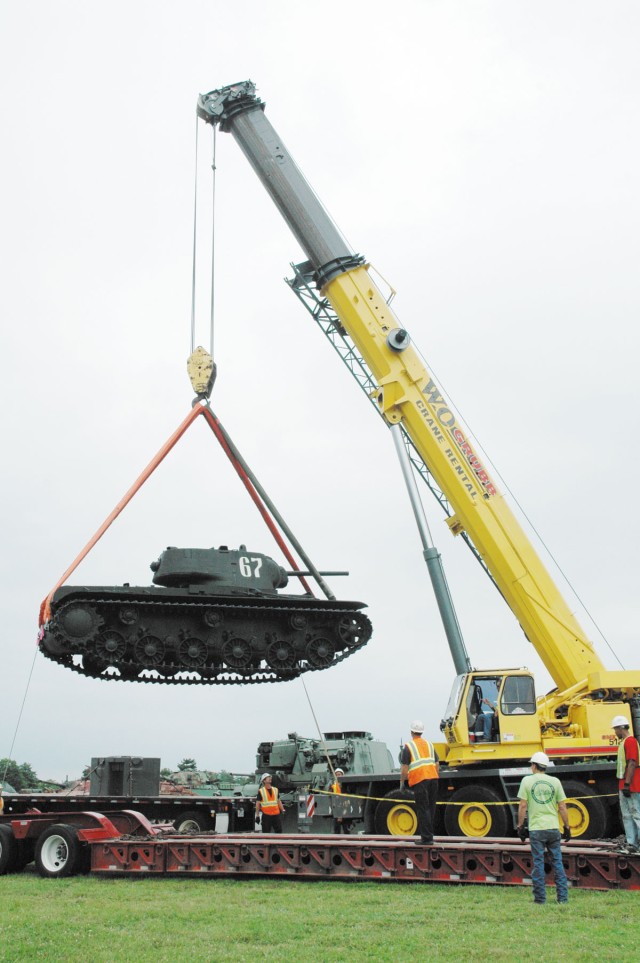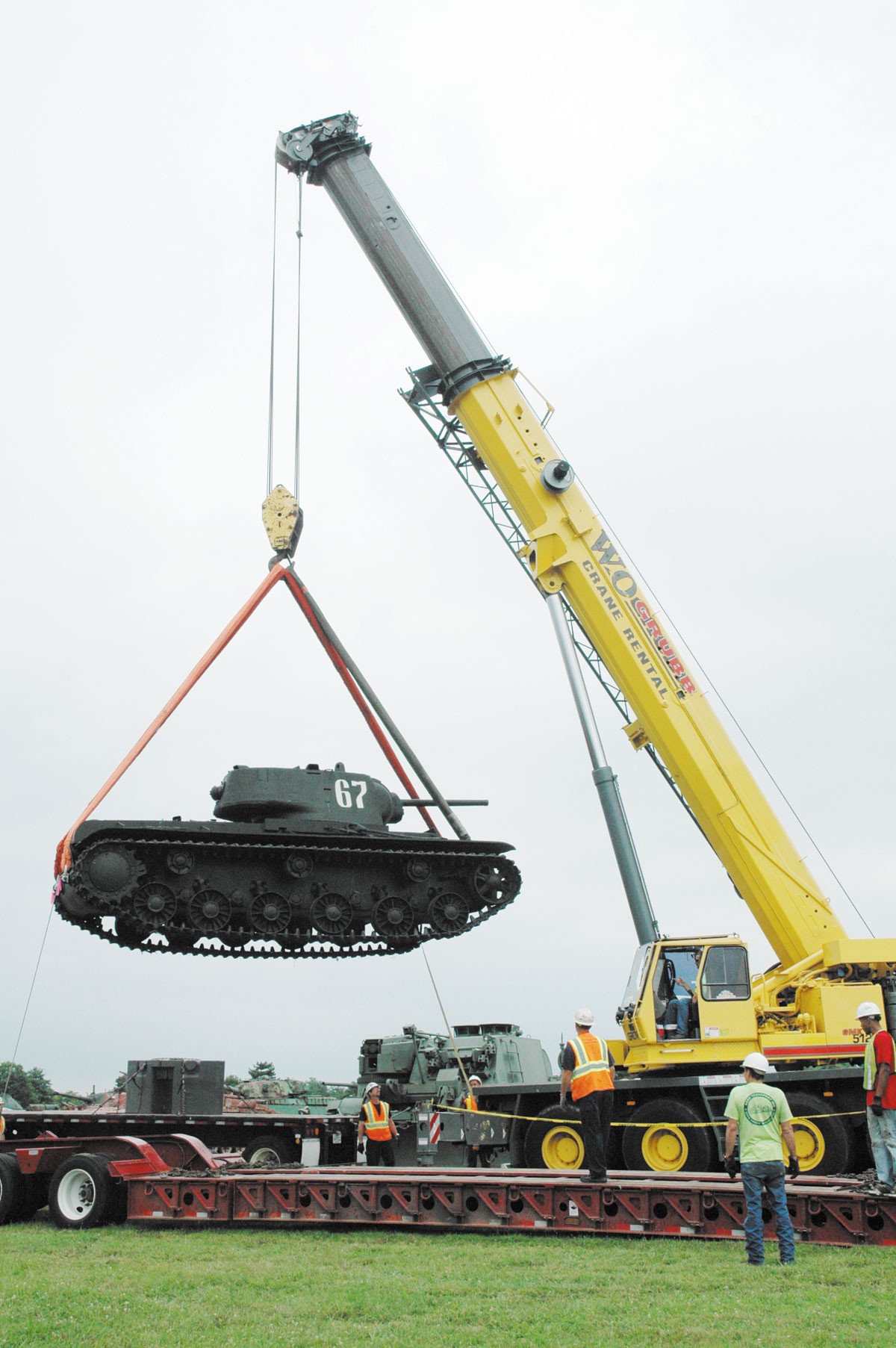
The first phase of the historic relocation of the U.S. Army Ordnance Museum took place Aug. 3 through 7.
That week saw the movement of 60 tanks and artillery pieces to Fort Lee, Va., which becomes the new home of the U.S. Army Ordnance Center and Schools under base realignment and closure.
Planning for the move began three years ago under the watchful eye of the U.S. Army Center of Military History's Army Museum Division and involved intricate coordination between OC&S leaders, the Ordnance Mechanical Maintenance School BRAC Office, the U.S. Army Combined Arms Support Command and Fort Lee, Ordnance Museum staff members and Aberdeen Proving Ground logisticians.
Two planners involved from the outset and who were on the ground Aug. 3 through 7 during the meticulous loading process was Jim Hardy, BRAC logistics planner from the OMMS BRAC Office, and Toni Probst, APG Garrison transportation officer.
Probst said when planning first began one of the first priorities was for the museum staff to provide an inventory of items and other specifics to obtain a clear picture of the requirements involved to eventually present for bid to transportation companies.
"We needed information like locations, dimensions, weight, sensitive items and weapons, and then had to divide that up into what was going and when," Probst said, adding that the move is being conducted in three phases with 2009 being the first phase and the other two occurring in 2010 and 2011.
Monthly teleconference meetings including all interested parties began in 2006. Careful consideration was given to packing, crating, unloading and other requirements," Probst said.
"We walked the carriers through the area so they could see the layout and determine what they could provide based on our needs," she said.
She said that planners decided to put each move up for bid as opposed to awarding one company the entire move.
"This way if one carrier didn't perform satisfactorily, we wouldn't have to use them again," she said. "We had to get an idea of the cost and told them to look at equipment, quantities, weights and other factors and then let us know what was needed."
Contractors had to submit their plans in February and the Transportation Office had a hand in the selection process, Probst said.
The Meadow Lark Transportation Company was provided the contract for Phase 1. Meadow Lark owner Robert Cade provided the drivers, trucks and cranes and used riggers from A&A Transport Inc. out of Virginia to perform the five-day operation.
Probst said the move went "very well" and credited Cade with overseeing the safe and careful movement of the museum assets.
"Rob Cade orchestrated it so well. He was responsive and took care of everything," she said, adding that the company also was responsible for restoring any damage to the grounds such as ruts left by its heavy trucks and cranes.
"This was a lot of work," Probst said. "No BRAC information officers from previous moves were still around to offer advice so it was a learning process, and we're still learning."
She said the office is sharing information with other installations and receiving valuable information in return.
"So far we've done well, and we hope to do even better with the next move," Probst said.
She said the after action review was very favorable and noted that museum director Dr. Joe Rainer, who was on the ground at Fort Lee for the offloading process that week, was pleased.
"Nothing was damaged and the transportation company took care of any damage to the grounds," she said.
Reflecting on what the movement of the museum means to the community, Probst recalled a sobering incident during the week of the move.
The museum was closed to the public for safety concerns, and Probst said she noticed an elderly gentleman who had earlier been told he would have to leave the grounds still there a while later.
"He was kneeling in front of a tank with his head bowed," she said. "A few minutes later, he got up, went to the next tank and kneeled again. I realized he was praying. That makes you understand the magnitude of what's happening here."
Jim Hardy led the OMMS Directorate of Instruction before retiring as a command sergeant major in 2005. He's been with the OMMS BRAC office for 10 months.
"I was hired on because this is similar to what I've done, and I'm familiar with the make up of the school and its assets," Hardy said.
Hardy worked long hours during Phase 1. He was in planning meetings with Cade by 6 a.m. each morning and ended each day planning for the next day's activities around 8 p.m.
He said his role was to make sure items were loaded properly, protected and secure before heading down the highway. In addition, he forwarded shipping information to Fort Lee so they would know what was arriving and when to plan their offloading operations.
"In this type of operation any number of things can go wrong but things went better than expected," Hardy said.
He thanked the APG Directorate of Emergency Services for providing traffic and crowd control and assisting the truckers, some of whom had to be escorted by Maryland State troopers due to their load specifics.
"[APG police officers] helped us when we brought in heavy equipment and checked on our equipment during the night," he said. "We were very grateful for their assistance."
He commended Cade and his workers for their competence.
"I would say they were extremely competent," he said. "Time management was no problem; there were no injuries and no safety violations. With all the delays, due to weather and traffic, we still finished on schedule. And, Meadow Lark left the grounds in better condition than they found them."
Hardy served as an Ordnance noncommissioned officer under three generals: Maj. Gen. James W. Monroe, 1994-1995; Maj. Gen. Robert D. Shadley, 1995-1997; and Brig. Gen. Thomas R. Dickenson, 1997-1998 - all of whom are in the Ordnance Hall of Fame.
He said that although the OC&S relocation "goes against the grain with a lot of people," it was "bound to happen."
"It's probably a good thing," he said. "The Ordnance Corps will finally move to a TRADOC [U.S. Army Training and Doctrine Command] installation with new facilities to train our ordnance Soldiers. And, APG doesn't lose anything because there's a large group moving in. It's a win-win for both installations."

Social Sharing